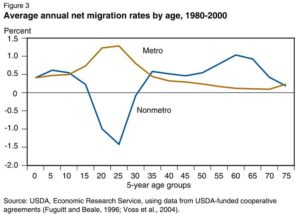 Image: Blog hero Plant Plate 09 boys dig in
Image: Blog hero Plant Plate 09 boys dig in
Think people, not place in rural migration
by Blandin Foundation Posted in Vibrant Rural

Ducks migrate for a reason. The Earth spins and triggers their “biological clock,” alerting them that it’s time to go. Global forces shape their movement.
Though human and duck migration patterns look very different and are driven by very different forces, according to geographer Jim Russell, one conclusion can be drawn – migration is a global affair.
In his keynote at Center for Small Towns Symposium, Russell stated that the dominant perception asserts that migration trends are the result of local or regional impacts, not global. Instead, Russell argued that global forces shape local migration trends. Using three economic eras in conjunction with “iconic migrations” – Manufacturing/Great Migration, Innovation/Sprawl, and Legacy/Urban Millennials – he demonstrated how the flow of people reflect the job opportunities of time.
So now that we know our kids are leaving the rural communities after high school and adults are returning in their 30s and 40s, what era are we in?
Russell calls it the Age of Return Migration (young people leave, get skilled, and return home) and it may just be the tool we need to rewrite the rural narrative.
How? It all goes back to how we talk about the patterns we already know are happening.
We’re seeing young people leave our rural communities. We mark it down in the “lose” column and quickly work to come up with a strategy to retain (a.k.a. restrain) our young folks so we can balance the tipping scale before it topples. That’s the old narrative. Chuck it out. Now!
Just because your community is exporting young talent does not mean you community has failed. In fact, in most cases, the migration of that young person is in your community’s best interest. People are returning to rural and they’re doing so when they’ve achieved a quality education, started families, and honed their personal and professional skills. It may take a little longer, but the wait is worth two marks in the “win” column.
Not only do people return with new skills to build community and more people to share in the work, they return with a Rolodex (sometimes physical, sometimes digital/internal/mental) of connections they’ve made in the urban area where they once lived. Armed with established networks and modern technology, entrepreneurs are flocking to rural to upgrade their quality of life. The communities that once exported the talent is now reaping the benefits of trained, connected, once-urban, now-rural returnees.
So when looking at the recipe your community uses for economic development, keep in mind:
- People who leave are not lost.
- If a person moves, think of them as a community connector who has the potential to create new economic ties. Identify those communities and start thinking about the possibilities.
- Migration patterns are global, not local. Your town of 1,000 cannot counteract the flow. Understand today’s migration patterns and plan accordingly.
- During the Age of Return Migration, rural has a real opportunity to grow the newcomer and returnee population by promoting quality of life and the technological infrastructure many need to be successful.